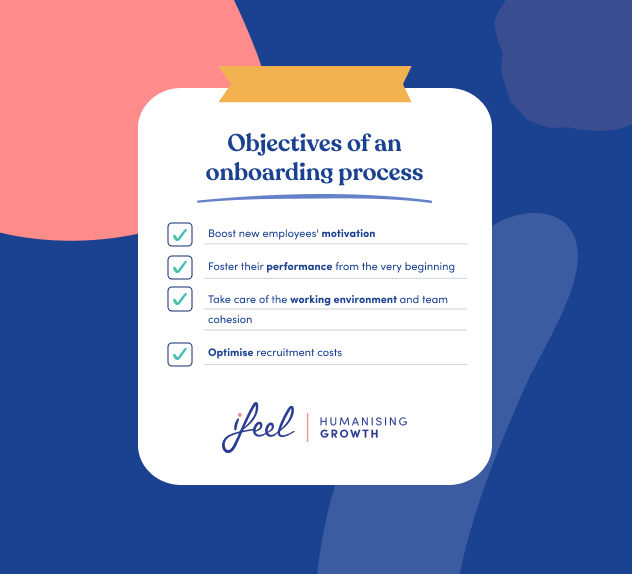Carrying out an efficient onboarding process includes a positive outcome in terms of the employees’ experience who are involved in it: the new hire, the team they join, and the manager who has the responsibility of leading this process.
To do this, it is important to consider the employees’ needs: those of the new employee and those of the team members they are joining. Secondly, it is necessary to have the ability to make the onboarding process a coherent continuation of the selection process that has been carried out to find the right employee for the position. Thirdly, it is essential to know that an onboarding process is not something that happens spontaneously but a strategic action that follows objectives whose achievement can be considered a good KPI for the Human Resources department.

Let’s look at these objectives in more detail.
Onboarding process objectives
1. Stimulate the new employee’s motivation
One of the objectives and benefits of a careful and responsible onboarding process is to welcome the new team member, ease their work, show them why and what we need them for, and encourage them to put all their talents to work progressively.
One might think that when someone starts working in a company, they do so with a high level of motivation regarding their position and the functions they will have to perform. It is not a far-fetched idea, but perhaps it is too simplistic since people’s situation is too complex to deduce that just because we are starting a job, we are already motivated.
2. Fostering their performance from the very beginning
Suppose the arrival starts on the right foot and the new employee perceives that the team’s attitude and – therefore – that of their new company as a whole are positive and open to welcoming them, as well as making things easier for them rather than demanding that they work magic. In that case, they will likely perform well from the very first moment. Even if they still have to complete a training period and acquire skills and competencies they do not yet possess.
3. Taking care of the work environment and team cohesion
The arrival of a new team member changes that person but also the structure and the affective and methodological dynamics of the group of people they join. Integrating this person requires an effort on both sides, which usually takes place spontaneously and satisfactorily but can be enhanced by raising awareness during the onboarding process.
Properly explaining the possible changes in responsibilities involved in the arrival of someone new, as well as the functions that this person will perform, making a good round of introductions to start the welcome, showing flexibility and availability in the process of adaptation of all, are some fundamental aspects of protecting the cohesion of the team and the work environment during an onboarding process.

4. Optimize recruitment costs
Filling a vacancy left by a former employee or starting up a new position that did not exist until now requires the company to incur a series of costs in terms of time and money. Not to mention the energy spent during a selection process, which should be carried out most efficiently.
A good onboarding process, which follows a good selection process, reduces the probability of failure in the new hire, which would mean starting from scratch to find a new employee, with all the costs that this would entail.
Are we carrying out a good onboarding process?
It is essential that HR managers, as well as the leaders of each department, are clear about what they do and do not do during the onboarding process of new employees.
Sometimes we do not know the best way to do things, or we do them because they have always been done that way, or we know that there are aspects of the onboarding process in our company that could improve. Still, we do not have the time or the necessary tools to do it, and we continue with our inertia. Whatever your case may be, we encourage you to find out thanks to this guide on carrying out a proper onboarding process prepared by our team of expert psychologists in workplace well-being.
In this guide, you will also find some tips on how to ensure the arrival of a new member has a positive impact on the team and avoids conflicts that may be costly to resolve later on.

Join the global leading solution in mental well-being
Improve emotional well-being in companies
At ifeel, we are solely committed to increasing employees’ and their companies’ well-being at work. That is why we want to help you in the challenge of generating stimulating and healthy work environments for your employees.
For this purpose, our psychologists have created an emotional well-being program for companies. Through this collaboration, your company’s human resources managers will be able to receive personalized, data-driven advice on how to improve their teams’ psychological well-being. On the other hand, this program provides employees with a complete mental health care service structured at different levels according to their needs. Try our program now to see how it can help you.
Visit our Resources section, where you will find podcasts on different topics (such as an employee experience guide), guides for Human Resources, or interviews with top HR managers. Moreover, take a look at the webinars we organized on occupational health and work environment climate.
In addition, you will have access to a Psychosocial Risk Factors Template, which will help you comply with the Labor Inspectorate’s requirements.
We hope this post on how to carry out a proper onboarding process has given you good ideas to make it easier for you to accomplish your tasks. Contact us to learn more about how our emotional well-being program for companies works. Get in touch, and we will get back to you as soon as possible.
What is the employee onboarding process?
The employee onboarding process is the series of activities and tasks that a new employee undergoes when joining an organization, aimed at integrating them into the company culture, familiarizing them with their role and responsibilities, and providing necessary resources and training.
How long does the employee onboarding process typically last?
The duration of the employee onboarding process can vary depending on the organization and the complexity of the role, however it usually spans from a few days to a few weeks, with some aspects of onboarding continuing throughout the first few months of employment.
What are the key components of the employee onboarding process?
Key components of the employee onboarding process often include completing paperwork and documentation, introducing the new employee to their team and colleagues, providing an overview of company policies and procedures, conducting orientation and training sessions, and setting performance expectations.
How does a well-executed employee onboarding process benefit the organization?
A well-executed employee onboarding process leads to several benefits for the organization, including higher employee engagement and satisfaction, faster integration and productivity, reduced turnover, and increased retention of top talent.
Who is typically involved in the employee onboarding process?
The employee onboarding process involves various stakeholders, including HR personnel, managers, team members, and sometimes representatives from different departments who are responsible for different aspects of the onboarding process, such as IT for setting up technology and equipment or trainers for providing job-specific training.









